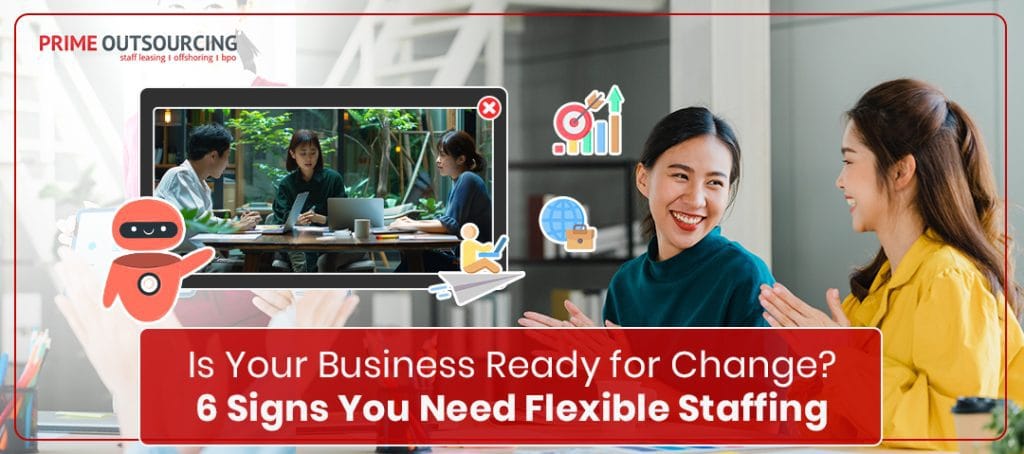
Flexible staffing, which allows businesses to scale their workforce up or down according to immediate needs, has become a popular solution to stay competitive and efficient. According to a report by the Bureau of Labor Statistics, the use of temporary workers grew by 11.6% in 2023 alone, indicating that businesses are turning to more agile workforce strategies.
If you’re wondering whether your business is ready for flexible staffing, here are six key indicators to help you decide.
Your business has fluctuating workloads and seasonal demands.
Does your business go through busy times and then slow seasons? Seasonal variations in the retail, hotel, or agricultural sectors can severely impact workforce planning. Flexible staffing allows you to bring in temporary or part-time workers during peak seasons, saving on expenditures during slower periods, rather than recruiting permanent employees who may not be needed year-round.
To satisfy the needs of the peak season, 85% of retail enterprises used temporary personnel, according to a Deloitte survey from 2019. This strategy guarantees that companies can satisfy client demands in times of peak demand without having to bear the expense of keeping a sizable, full-time staff in less busy months.

You need specialized skills on short-term projects.
Businesses frequently find themselves in need of specialized skills as they innovate and diversify. These abilities might, however, only be necessary for a few distinct short-term tasks. For the duration of a project, organizations can access a pool of skilled individuals by utilizing flexible staffing instead of hiring full-time personnel with specialized knowledge.
For example, when introducing new goods or services, tech companies usually depend on flexible staffing options. 74% of technology businesses utilize flexible or project-based personnel to swiftly acquire specialized talents without the long-term commitment of a full-time hire, according to LinkedIn’s Global Personnel Trends 2022.

There are budget constraints for full-time hiring.
Employing full-time workers incurs costs for benefits, insurance, and paid time off in addition to wages. If your business is experiencing financial difficulties, flexible staffing presents an affordable option. Businesses can still meet operational objectives while avoiding the long-term financial burden of full-time hires by using temporary or freelance labor.
According to a ManpowerGroup report, budget constraints are the main reason why 63% of businesses use flexible workforce solutions. This strategy keeps companies flexible without sacrificing the caliber of its personnel.

Business uncertainty due to economic conditions.
Hiring decisions may be significantly impacted by economic instability. Businesses could be reluctant to commit to full-time hires during unstable times. Businesses can scale their workforce in response to the state of the economy with the help of flexible staffing.
A survey by McKinsey & Company revealed that 54% of global businesses adopted flexible staffing during the COVID-19 pandemic as a response to economic uncertainty. In turbulent markets, this technique allowed businesses to continue operating while keeping control over payroll costs.

Your business is growing or expanding.
Is your business expanding or entering new markets? Rapid growth often requires immediate staffing solutions to meet new demands. However, hiring full-time employees during a growth phase can be risky, as future workloads may be unpredictable.
Flexible staffing provides the agility needed to scale up quickly without the long-term commitment. According to the Society for Human Resource Management (SHRM), 70% of growing businesses rely on flexible workforce models during expansion phases, allowing them to maintain momentum without being weighed down by permanent staffing costs.

Retention and burnout challenges among your full-time staff.
Overworked employees are more likely to experience burnout, leading to decreased productivity, increased absenteeism, and higher turnover rates. According to a Gallup study, 76% of employees reported experiencing burnout at least occasionally, and 28% said they felt burned out “very often” or “always” at work.
If your full-time staff is stretched too thin, bringing in temporary or part-time workers through flexible staffing can alleviate some of the pressure. This helps maintain work-life balance for your core team, reduces turnover, and prevents burnout. In turn, your full-time employees can focus on strategic, long-term tasks while temporary staff handle day-to-day or high-volume activities.

Conclusion
As your business navigates through periods of changes, the question isn’t if you should adopt flexible staffing but when. With the increase in reliance on this model, flexible staffing could be the key to keeping your business agile and competitive.
From saving on costs to boosting productivity, flexible staffing solutions offer a dynamic approach to workforce management that’s perfectly suited to today’s ever-changing business landscape.
Avail Flexible Staffing Services at PrimeOutsourcing
Ready to take the step forward in business growth? Work with PrimeOutsourcing. We have affordable flexible staffing solutions to provide your business.
Whether you need specialized talent for short-term projects or a scalable workforce for seasonal demands, we’ve got you covered. Let us help you stay agile and competitive in today’s dynamic market.
Read more: Flexible Staffing Solutions: The Key for Business Dynamic Needs



